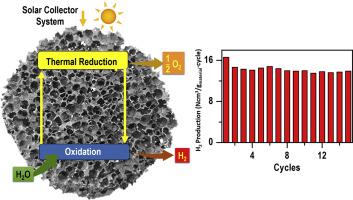International Journal of Hydrogen Energy ( IF 8.1 ) Pub Date : 2020-05-26 , DOI: 10.1016/j.ijhydene.2020.04.222 María Orfila , Daniel Sanz , María Linares , Raúl Molina , Raúl Sanz , Javier Marugán , Juan Ángel Botas

|
In this work, we present for the first time the preparation and evaluation of Ceria-based mixed oxides reticulated porous ceramic (RPC) structures for H2 production by thermochemical water splitting. After appropriate screening of the powder materials, ceria-based materials modified with Co, Mn and Zr were discarded due to their low cyclability and/or hydrogen productivity, derived from segregation of active phases or sintering during the thermal reduction and reoxidation. Sponge replica method has been optimized to allow obtaining a Ce0.9Fe0.1Oy RPC sponge structure with an outstanding hydrogen production of 15 STPcm3/gmaterial·cycle at a maximum temperature of 1300 °C. This better performance, comparing to the powder, can be attributed to the open macroporosity of the reticulated porous structure which enhances both heat and mass transfer. The H2 production is maintained along several consecutive cycles without loss of activity, reinforcing the favorable prospects for large-scale hydrogen production.
中文翻译:

二氧化铈基混合氧化物材料的网状多孔结构通过热化学水分解产生H 2的方法
在这项工作中,我们首次提出了通过热化学水分解法制备和评价用于H 2生产的二氧化铈基混合氧化物网状多孔陶瓷(RPC)结构的方法。在对粉末材料进行适当的筛选后,由于它们的低循环能力和/或氢生产率(源自热还原和再氧化过程中的活性相偏析或烧结)而被废弃,因此用Co,Mn和Zr改性的二氧化铈基材料被丢弃。海绵复制品方法已被优化,以允许获得的Ce 0.9铁0.1 ø ý具有杰出制氢15 STPcm的RPC海绵结构3 / g的材料·在最高温度1300°C下循环。与粉末相比,这种更好的性能可归因于网状多孔结构开放的大孔,从而增强了传热和传质。在连续的几个循环中保持H 2的产生而没有活性的损失,从而增强了大规模制氢的有利前景。











































 京公网安备 11010802027423号
京公网安备 11010802027423号